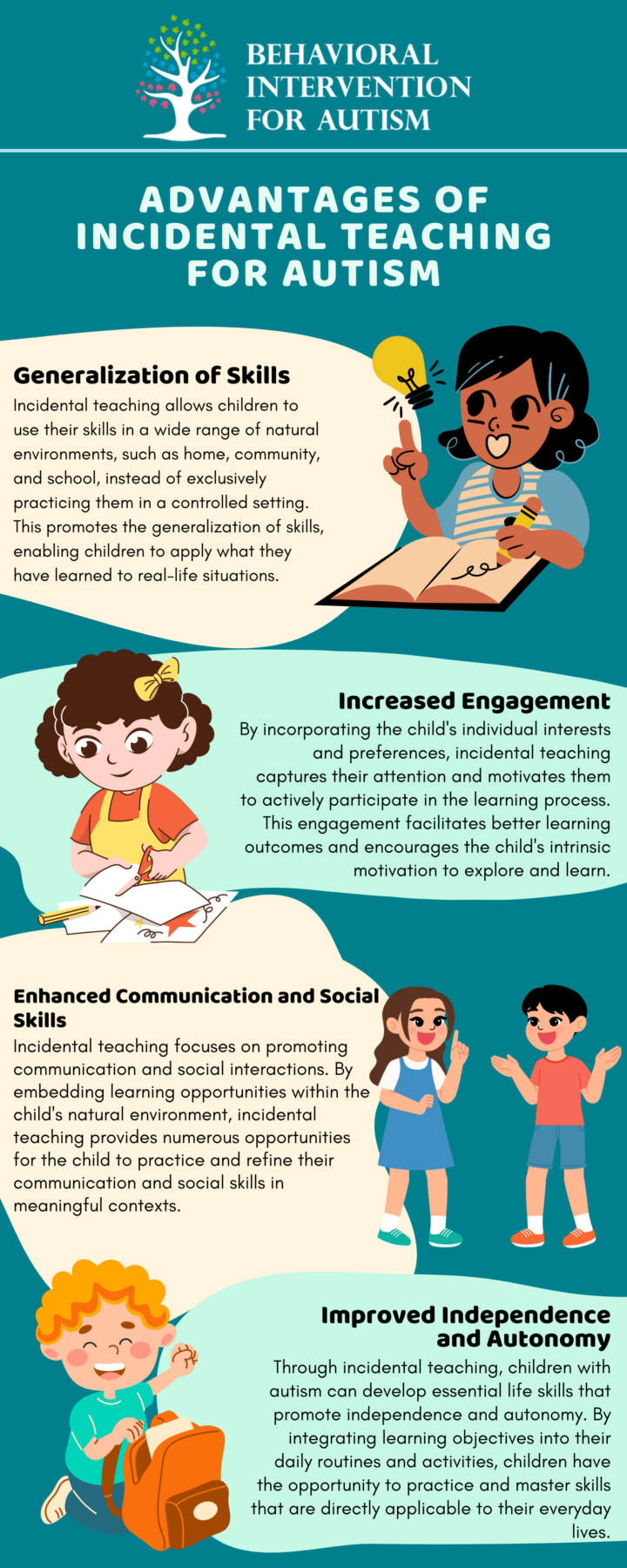
Table of Contents
Incidental teaching is a valuable approach in the realm of teaching and learning, especially for individuals with autism. The following will define incidental teaching and emphasize how crucial individual interests are in this approach.
what is incidental teaching?
Incidental teaching is a form of teaching where a teacher utilizes naturally occurring incidents or situations to provide learning opportunities for pupils. Rather than following a structured curriculum or lesson plan, incidental teaching takes advantage of spontaneous moments to engage learners in meaningful activities. It involves capitalizing on the learner’s interests and incorporating them into the teaching process.
Incorporating the learner’s interests, such as using a video game or favorite book characters, makes the learning relevant and meaningful to the student’s life. This approach encourages active participation and engagement, fostering a more natural and enjoyable learning experience.

importance of individual interests
One of the key aspects of incidental teaching is the recognition and utilization of individual interests. This is based on the understanding that students, including those on the autism spectrum, are more receptive to learning when the teaching is centered around their interests. By incorporating these interests into the learning process, incidental teaching can help to create a positive and motivating learning environment.
Engaging individuals with autism in activities aligned with their interests significantly enhances their involvement, focus, and motivation to learn. This strategy leverages their natural curiosity and fosters personalized learning experiences. Integrating interests and daily life into lessons through incidental teaching can effectively connect academic concepts with real-world applications, making the learning experience more meaningful and relevant.
Leveraging individual interests in incidental teaching improves learning for children with autism and benefits all students by fostering a student-centered environment that values each learner’s uniqueness. This approach creates engaging and effective learning opportunities tailored to diverse needs. We’ll explore incidental teaching, its role in applied behavior analysis, the skills it targets, and how to implement it effectively.
implementing incidental teaching
To effectively implement incidental teaching, it is important to create a learning environment that maximizes opportunities for learning and engagement. The implementation of incidental teaching revolves around two main elements: structuring the learning environment and fostering student engagement.
organizing the learning environment
To effectively use incidental teaching, it is crucial to arrange the learning environment to both support the educational process and promote active participation from the student. Here are some strategies to consider:
- Structured Set-Up: Create a structured yet flexible environment that allows for spontaneous learning opportunities. Arrange materials and activities in an accessible manner, making it easy for the student to engage with them.
- Visual Supports: Use visual supports such as visual schedules, visual cues, and visual prompts to enhance understanding and provide clarity. Visual supports can assist in guiding the student’s attention and promoting independence during learning interactions.
- Choice-making: Offer choices within the learning environment to empower the student and promote their autonomy. By providing choices, you can tap into their individual preferences and interests, which can enhance motivation and engagement.
- Functional Communication: Encourage the use of functional communication by incorporating visual or verbal prompts that prompt the student to request desired items or activities. This helps to develop their communication skills while providing opportunities for incidental teaching.
encouraging the student engagement
Engaging the student is a crucial aspect of incidental teaching. Here are some strategies to encourage student engagement:
- Follow the Student’s Lead: Pay attention to the student’s interests and preferences, and follow their lead during learning interactions. By incorporating their interests into the learning process, you can enhance their engagement and motivation.
- Provide Natural Reinforcement: Utilize natural reinforcement by providing positive feedback, praise, or access to preferred items or activities when the student demonstrates desired behaviors or makes progress toward learning objectives. This helps to reinforce the connection between their actions and positive outcomes.
- Use Prompting Techniques: Use prompting techniques to support the student’s learning and encourage their active participation. Gradually fade prompts as the student becomes more independent, allowing them to take greater ownership of their learning.
- Embed Learning Opportunities: Look for natural opportunities throughout the day to embed learning experiences. For example, during playtime or daily routines, create situations where the student can practice target skills in a meaningful context. This helps to generalize learned skills to various environments and promotes functional application.
Organizing the learning environment and actively engaging the student are key elements in implementing incidental teaching to support learning and skill development. Tailoring strategies to the individual needs and preferences of the student helps to create a supportive and enriching learning experience.
incidental teaching in autism therapy
Incidental teaching plays a significant role in the field of Applied Behavior Analysis (ABA) therapy, a widely used approach for individuals with autism. This naturalistic teaching method focuses on creating learning opportunities within the child’s natural environment, harnessing everyday situations to promote skill development. Let’s explore the role of incidental teaching in ABA and the developmental skills it targets.
role in applied behavior analysis
Incidental teaching has been utilized in ABA therapy since the 1970s, making it one of the pioneering naturalistic teaching techniques in contrast to traditional methods like Discrete Trial Training (DDT). ABA therapists incorporate incidental teaching to encourage social interaction, independent problem-solving skills, and spontaneous communication.
Capitalizing on a child’s natural interests and motivations, incidental teaching fosters a dynamic learning environment that encourages active engagement and participation. This approach acknowledges that learning is most effective when it is meaningful, relevant, and integrated into the child’s daily life.

developmental skills targeted
Incidental teaching within ABA therapy targets a range of developmental skills that are crucial for individuals with autism. This approach aims to enhance various areas, including but not limited to:
- Language Development: Incidental teaching provides opportunities for children to practice and expand their communication skills. Embedding language learning within natural interactions and activities promotes sentence formation, vocabulary development, and expressive language skills.
- Play Skills: Through incidental teaching, therapists encourage and facilitate play interactions that promote sharing, imaginative play, turn-taking, and problem-solving. This helps children with autism develop essential social and play skills that are important for peer interactions and overall social development.
- Behavioral Regulation: Incidental teaching can also target behavioral regulation skills, such as emotional regulation, self-control, and following instructions. By incorporating behavior management strategies within natural contexts, this approach helps individuals with autism develop appropriate behavioral responses and self-regulation skills.
- Cognitive Skills: Incidental teaching supports the development of cognitive skills, including problem-solving, critical thinking, and decision-making. By presenting real-life scenarios and opportunities for decision-making, individuals with autism can practice and enhance their cognitive abilities within meaningful contexts.
- Generalization of Skills: One of the key benefits of incidental teaching is its focus on generalization. Teaching skills within natural environments helps individuals with autism transfer and apply learned skills to various settings and situations, promoting greater independence and adaptability.
Incidental teaching in ABA therapy provides a valuable framework for fostering skill development in individuals with autism. By incorporating this approach, therapists can create a supportive learning environment that promotes the acquisition and generalization of essential skills, empowering individuals with autism to thrive in their everyday lives.
utilizing incidental teaching
Incidental teaching is a powerful teaching method that can be utilized by various professionals involved in the care and education of children with autism. These professionals may include speech pathologists, occupational therapists, psychologists, special education teachers, aides, or parents. By incorporating incidental teaching into their practice, they can help children with autism learn how to communicate, respond, and act effectively in various everyday situations.
professionals involved
Each professional brings their unique skills and knowledge to create a comprehensive and individualized learning experience. Here are some of the professionals who may utilize incidental teaching:
- Speech Pathologist – Focuses on improving communication and language skills.
- Occupational Therapist – Aims to enhance daily living skills and fine motor skills.
- Psychologist– Provides support for emotional and behavioral challenges.
- Special Education Teacher – Develops and implements educational strategies and curriculum.
- Aide – Assists in implementing therapy and supporting the child’s learning.
- Parents/Caregivers – Play a vital role in implementing incidental teaching in everyday life.
Combining the efforts of these professionals fosters a collaborative and holistic approach to supporting children with autism in their learning and development.
benefits for children with autism
In integrating learning objectives into the child’s natural environment and individual interests, incidental teaching offers a more naturalistic and engaging learning experience. Here are some key benefits of incorporating incidental teaching:

Incorporating incidental teaching into interventions and support programs for children with autism, such as in-home Applied Behavior Analysis therapy, can have a profound impact on their overall development and quality of life. It allows for a more holistic and individualized approach to learning, paving the way for meaningful progress and long-term success.
At Behavioral Intervention for Autism, we offer high-quality ABA therapy in Florida, tailored to meet the unique needs of each child. Our dedicated team is committed to helping your child achieve their fullest potential.
Contact us today to learn more about our services and how we can support your family’s journey.
Sources:
https://www.fau.edu/education/centersandprograms/card/documents/incidentalteaching.pdf
https://www.webmd.com/parenting/what-is-incidental-teaching
https://knappcenter.org/wp-content/uploads/2017/05/Topic-3_Incidental-Teaching-Guide.pdf
https://engage-education.com/us/blog/incidental-teaching-what-is-it-when-can-it-be-used/
- 9 Common Obsessions of Children With Autism You Should Know - February 25, 2025
- What is Neurodiversity? A Guide to Embracing Differences - February 25, 2025
- Understanding Hyperfocus in Autism: What It Means and Why It Happens - February 25, 2025
